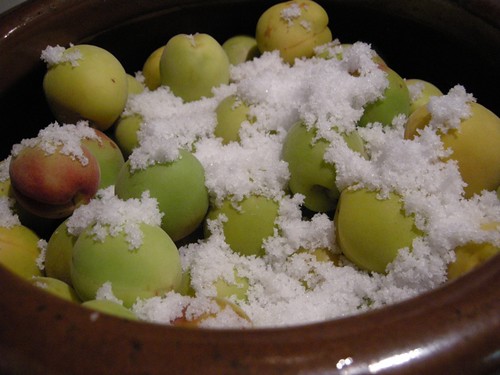 After our Berkeley backyard ume foraging adventure, Yoko, Sylvan (of Peko Peko) and I met up six days later to start pickling our umeboshi (pickled plum). Hooray! Umeboshi is the rice accompaniment of choice in Japan--the image of the sour little scarlet ball, sitting on a bed of steaming rice for breakfast, is as ubiquitous as the peanut butter sandwich here in the States.
After our Berkeley backyard ume foraging adventure, Yoko, Sylvan (of Peko Peko) and I met up six days later to start pickling our umeboshi (pickled plum). Hooray! Umeboshi is the rice accompaniment of choice in Japan--the image of the sour little scarlet ball, sitting on a bed of steaming rice for breakfast, is as ubiquitous as the peanut butter sandwich here in the States.
The thought of
umeboshi makes my face pucker in an instant, and my mouth waters as I feel the sourness piercing my tongue. The pit is to be savored. Whenever I visited my aunt in Yokohama growing up, she would have this vat of really gorgeous, honey-soaked
umeboshi, the size of a ¥500 coin. These are sweeter, soft, and velvety, and she would only let me eat one a day, they were so highly-prized. I looked forward to my daily
umeboshi, and would sneakily pop another into my mouth while she was out hanging the laundry.
My dear friend Naoko Ogigami's film MEGANE also comes to mind when thinking about
umeboshi. Naoko has an intense passion for eating, and will often even have a food stylist on set.
http://www.youtube.com/watch?v=5AFvUOOMrKs
Naoko devotes many scenes to
umeboshi in MEGANE, as the characters all sit around the dining table of a dreamy island inn, and ritualistically speak of the pickled plum. In one of my favorite scenes, the innkeeper, who pickles his own plums every year, recites an old saying, "梅干しはその日のなんのがれ" ("
umeboshi wa sonohi no nannogare" = umeboshi wards off danger for the day). He continues with, "Umeboshi and friends: The older, the better."
Which is all to say that umeboshi plays a mythical, all-powerful, culture-dominating role in Japan's history that goes far beyond just for eating. Yoko and I were really excited about making a 2011 batch with Sylvan.
A few days prior, we accompanied Sylvan to
Tokyo Fish Market and bought out all the
ume they had left for the season. Like I said before, the season for ume is fleeting, so you really need to snatch them up when you see them. We would be using everything we foraged and the two big boxes we bough to make
umeboshi and
umeshu (plum wine).
We inspected each
ume:
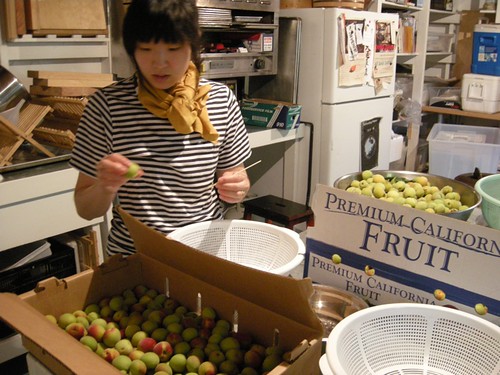
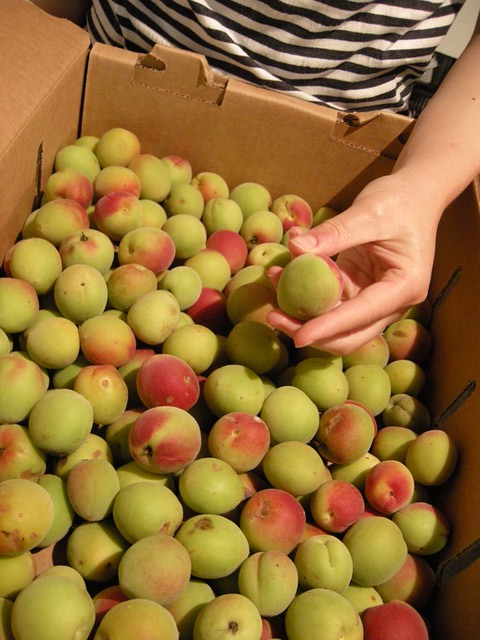
Took out the little stub of what was left of the stem with a toothpick:
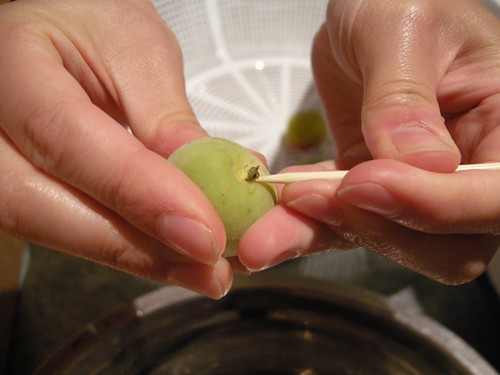
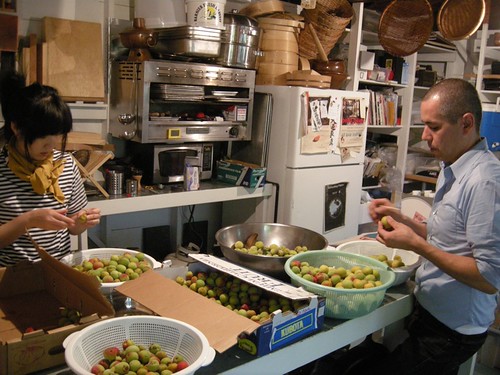 We carefully washed them, laid them on slats to properly dry, and divided them up between the good, the bad, and the ugly. The prettiest ones would be used for umeboshi, and all the others for the umeshu.
We carefully washed them, laid them on slats to properly dry, and divided them up between the good, the bad, and the ugly. The prettiest ones would be used for umeboshi, and all the others for the umeshu.
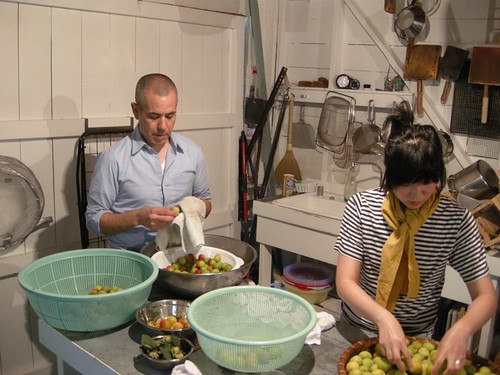
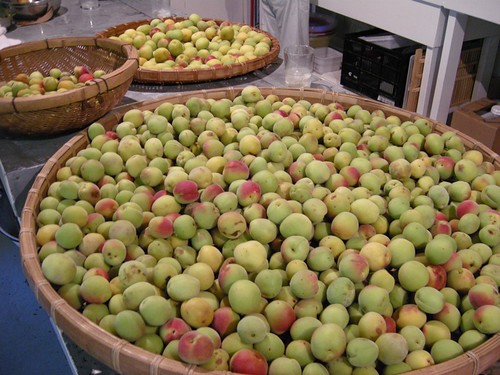
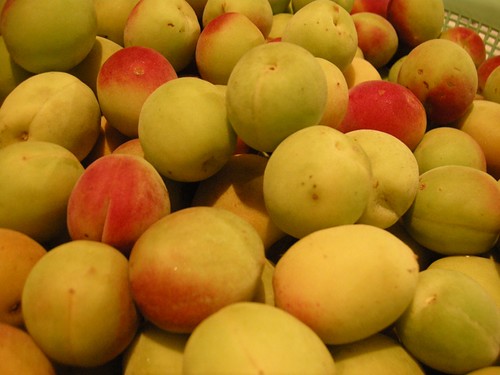 UMEBOSHI (Pickled Plums)
UMEBOSHI (Pickled Plums)
INGREDIENTS
Turns out that pickling
ume is incredibly easy. We consulted two Japanese cookbooks--one said that with however much
ume you have in weight, 15% of it should be salt. Another said 20%. Sylvan wanted them on the sweeter side, so we went with 14%.
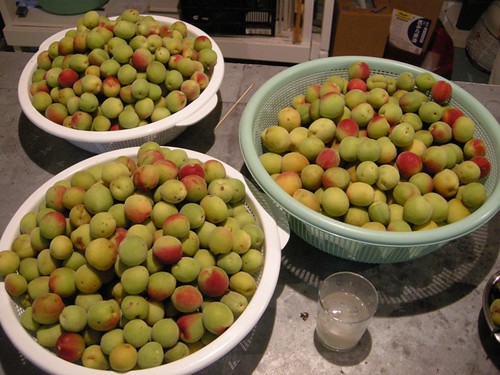
We used bags of salt from Japan.
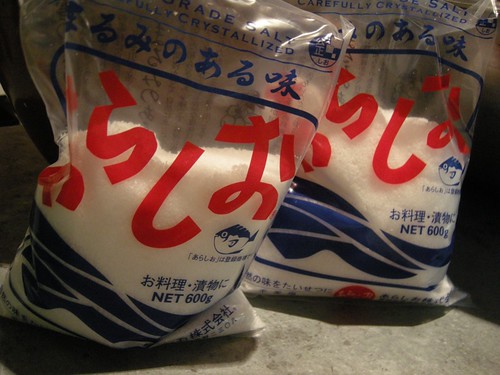
Nothing special about this salt per se, but Sylvan wanted to use ingredients they would in Japan, to end with a similar product.
In total, we had about 2.25kg of ume for the umeboshi (roughly 5lbs). So we measured out about 2254g of salt.
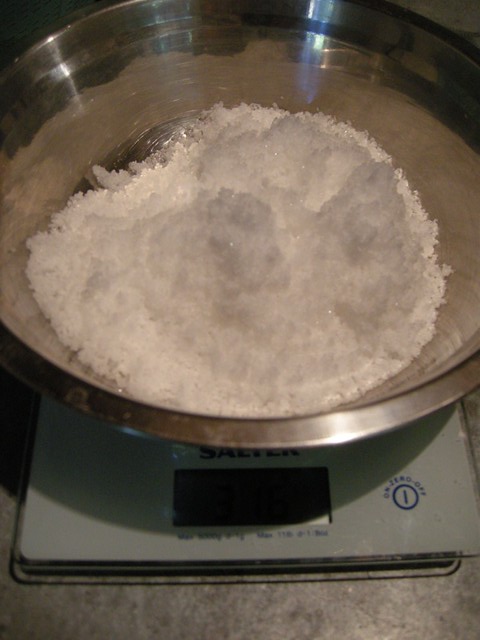 METHOD
METHOD
1. Start layering and sprinkling salt over the
ume.
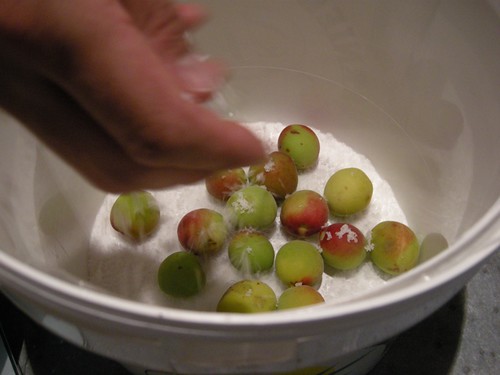
2. Keep doing this, occasionally stirring the salt and ume with your hands to make sure the salt is evenly distributed. Push down on the ume to compress.
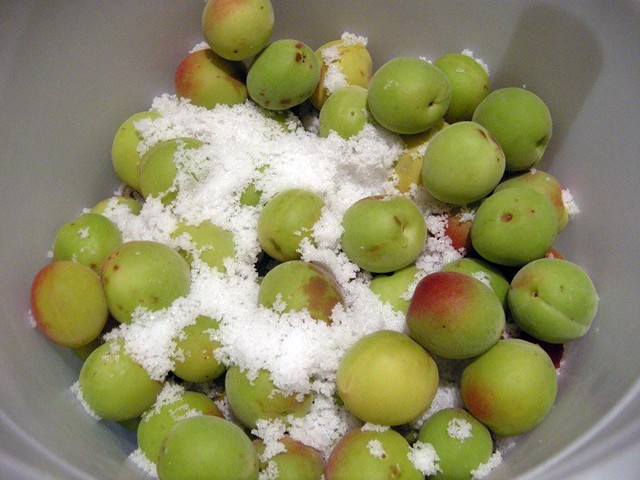
3. Then, push down with a plate or something with a sturdy flat surface. You will use this so you can lay something VERY heavy on top, to weigh it down and compress the
ume.
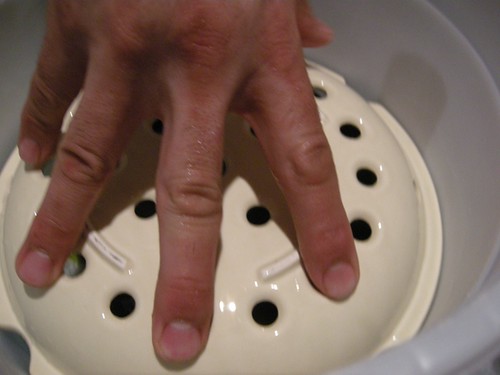
4. Take off the plate for a second and properly saran wrap the top of the container. Place plate on top of the wrap.
5. We bagged some bricks to use as weights for this.
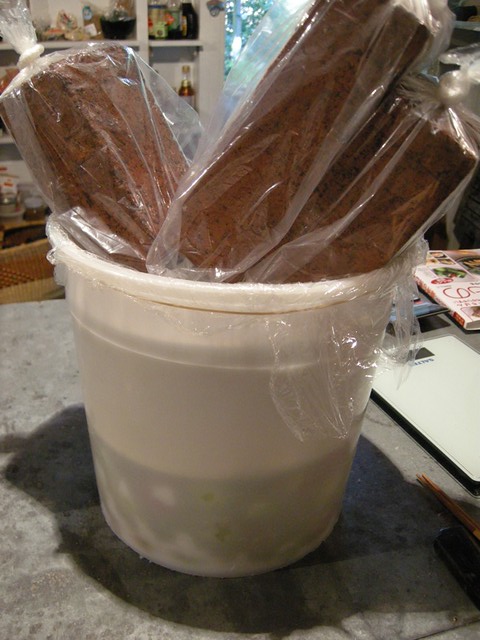
Traditionally, you'll use a ceramic container for pickling, like this for our other batch. We repeated the same exact steps above.
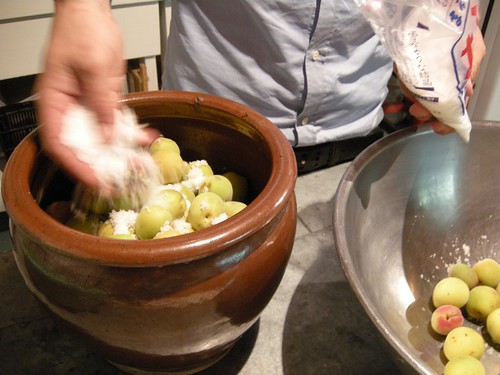
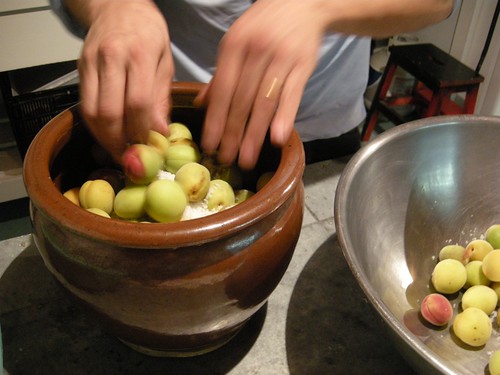
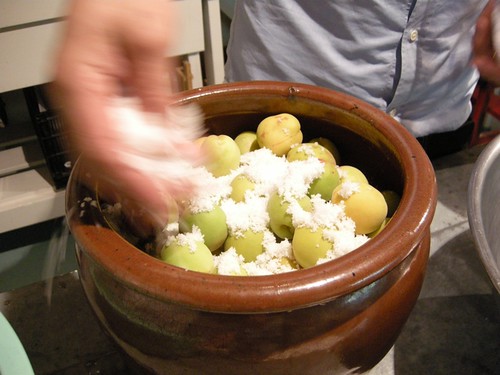
Wrap.

Weigh down.
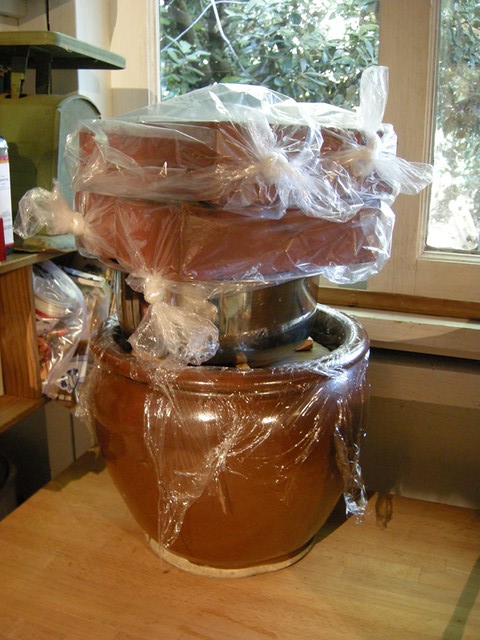
We'll need to add red shiso leaves soon. We're looking for a large quantity, so if anyone out there has a source for it, please let us know.
Now, we just wait. And wait. And wait. As the innkeeper said in MEGANE,
umeboshi and friends, the older, the better.
Sylvan emailed me the other day: "The
umeboshi are doing very well-- beautiful color (even without shiso) and completely submerged in their own juice. They smell divine, too."
I hope these
umeboshi turn out well, and I'll be posting the progress from time to time here on Umamimart. Yamahomo had commented that we should have put the
ume in a paper bag to let them ripen a bit. We did see that the
ume in the cookbooks were also a bit more yellow, but we just went for it. Patience is a virtue, but cooking is also all about trial and error.
Om shanti namaste.
Next up,
umeshu (plum wine)!
 After our Berkeley backyard ume foraging adventure, Yoko, Sylvan (of Peko Peko) and I met up six days later to start pickling our umeboshi (pickled plum). Hooray! Umeboshi is the rice accompaniment of choice in Japan--the image of the sour little scarlet ball, sitting on a bed of steaming rice for breakfast, is as ubiquitous as the peanut butter sandwich here in the States.
The thought of umeboshi makes my face pucker in an instant, and my mouth waters as I feel the sourness piercing my tongue. The pit is to be savored. Whenever I visited my aunt in Yokohama growing up, she would have this vat of really gorgeous, honey-soaked umeboshi, the size of a ¥500 coin. These are sweeter, soft, and velvety, and she would only let me eat one a day, they were so highly-prized. I looked forward to my daily umeboshi, and would sneakily pop another into my mouth while she was out hanging the laundry.
My dear friend Naoko Ogigami's film MEGANE also comes to mind when thinking about umeboshi. Naoko has an intense passion for eating, and will often even have a food stylist on set.
http://www.youtube.com/watch?v=5AFvUOOMrKs
Naoko devotes many scenes to umeboshi in MEGANE, as the characters all sit around the dining table of a dreamy island inn, and ritualistically speak of the pickled plum. In one of my favorite scenes, the innkeeper, who pickles his own plums every year, recites an old saying, "梅干しはその日のなんのがれ" ("umeboshi wa sonohi no nannogare" = umeboshi wards off danger for the day). He continues with, "Umeboshi and friends: The older, the better."
Which is all to say that umeboshi plays a mythical, all-powerful, culture-dominating role in Japan's history that goes far beyond just for eating. Yoko and I were really excited about making a 2011 batch with Sylvan.
A few days prior, we accompanied Sylvan to Tokyo Fish Market and bought out all the ume they had left for the season. Like I said before, the season for ume is fleeting, so you really need to snatch them up when you see them. We would be using everything we foraged and the two big boxes we bough to make umeboshi and umeshu (plum wine).
We inspected each ume:
After our Berkeley backyard ume foraging adventure, Yoko, Sylvan (of Peko Peko) and I met up six days later to start pickling our umeboshi (pickled plum). Hooray! Umeboshi is the rice accompaniment of choice in Japan--the image of the sour little scarlet ball, sitting on a bed of steaming rice for breakfast, is as ubiquitous as the peanut butter sandwich here in the States.
The thought of umeboshi makes my face pucker in an instant, and my mouth waters as I feel the sourness piercing my tongue. The pit is to be savored. Whenever I visited my aunt in Yokohama growing up, she would have this vat of really gorgeous, honey-soaked umeboshi, the size of a ¥500 coin. These are sweeter, soft, and velvety, and she would only let me eat one a day, they were so highly-prized. I looked forward to my daily umeboshi, and would sneakily pop another into my mouth while she was out hanging the laundry.
My dear friend Naoko Ogigami's film MEGANE also comes to mind when thinking about umeboshi. Naoko has an intense passion for eating, and will often even have a food stylist on set.
http://www.youtube.com/watch?v=5AFvUOOMrKs
Naoko devotes many scenes to umeboshi in MEGANE, as the characters all sit around the dining table of a dreamy island inn, and ritualistically speak of the pickled plum. In one of my favorite scenes, the innkeeper, who pickles his own plums every year, recites an old saying, "梅干しはその日のなんのがれ" ("umeboshi wa sonohi no nannogare" = umeboshi wards off danger for the day). He continues with, "Umeboshi and friends: The older, the better."
Which is all to say that umeboshi plays a mythical, all-powerful, culture-dominating role in Japan's history that goes far beyond just for eating. Yoko and I were really excited about making a 2011 batch with Sylvan.
A few days prior, we accompanied Sylvan to Tokyo Fish Market and bought out all the ume they had left for the season. Like I said before, the season for ume is fleeting, so you really need to snatch them up when you see them. We would be using everything we foraged and the two big boxes we bough to make umeboshi and umeshu (plum wine).
We inspected each ume:

 Took out the little stub of what was left of the stem with a toothpick:
Took out the little stub of what was left of the stem with a toothpick:

 We carefully washed them, laid them on slats to properly dry, and divided them up between the good, the bad, and the ugly. The prettiest ones would be used for umeboshi, and all the others for the umeshu.
We carefully washed them, laid them on slats to properly dry, and divided them up between the good, the bad, and the ugly. The prettiest ones would be used for umeboshi, and all the others for the umeshu.


 UMEBOSHI (Pickled Plums)
INGREDIENTS
Turns out that pickling ume is incredibly easy. We consulted two Japanese cookbooks--one said that with however much ume you have in weight, 15% of it should be salt. Another said 20%. Sylvan wanted them on the sweeter side, so we went with 14%.
UMEBOSHI (Pickled Plums)
INGREDIENTS
Turns out that pickling ume is incredibly easy. We consulted two Japanese cookbooks--one said that with however much ume you have in weight, 15% of it should be salt. Another said 20%. Sylvan wanted them on the sweeter side, so we went with 14%.
 We used bags of salt from Japan.
We used bags of salt from Japan.
 Nothing special about this salt per se, but Sylvan wanted to use ingredients they would in Japan, to end with a similar product.
In total, we had about 2.25kg of ume for the umeboshi (roughly 5lbs). So we measured out about 2254g of salt.
Nothing special about this salt per se, but Sylvan wanted to use ingredients they would in Japan, to end with a similar product.
In total, we had about 2.25kg of ume for the umeboshi (roughly 5lbs). So we measured out about 2254g of salt.
 METHOD
1. Start layering and sprinkling salt over the ume.
METHOD
1. Start layering and sprinkling salt over the ume.
 2. Keep doing this, occasionally stirring the salt and ume with your hands to make sure the salt is evenly distributed. Push down on the ume to compress.
2. Keep doing this, occasionally stirring the salt and ume with your hands to make sure the salt is evenly distributed. Push down on the ume to compress.
 3. Then, push down with a plate or something with a sturdy flat surface. You will use this so you can lay something VERY heavy on top, to weigh it down and compress the ume.
3. Then, push down with a plate or something with a sturdy flat surface. You will use this so you can lay something VERY heavy on top, to weigh it down and compress the ume.
 4. Take off the plate for a second and properly saran wrap the top of the container. Place plate on top of the wrap.
5. We bagged some bricks to use as weights for this.
4. Take off the plate for a second and properly saran wrap the top of the container. Place plate on top of the wrap.
5. We bagged some bricks to use as weights for this.
 Traditionally, you'll use a ceramic container for pickling, like this for our other batch. We repeated the same exact steps above.
Traditionally, you'll use a ceramic container for pickling, like this for our other batch. We repeated the same exact steps above.


 Wrap.
Wrap.
 Weigh down.
Weigh down.
 We'll need to add red shiso leaves soon. We're looking for a large quantity, so if anyone out there has a source for it, please let us know.
Now, we just wait. And wait. And wait. As the innkeeper said in MEGANE, umeboshi and friends, the older, the better.
Sylvan emailed me the other day: "The umeboshi are doing very well-- beautiful color (even without shiso) and completely submerged in their own juice. They smell divine, too."
I hope these umeboshi turn out well, and I'll be posting the progress from time to time here on Umamimart. Yamahomo had commented that we should have put the ume in a paper bag to let them ripen a bit. We did see that the ume in the cookbooks were also a bit more yellow, but we just went for it. Patience is a virtue, but cooking is also all about trial and error.
Om shanti namaste.
Next up, umeshu (plum wine)!
We'll need to add red shiso leaves soon. We're looking for a large quantity, so if anyone out there has a source for it, please let us know.
Now, we just wait. And wait. And wait. As the innkeeper said in MEGANE, umeboshi and friends, the older, the better.
Sylvan emailed me the other day: "The umeboshi are doing very well-- beautiful color (even without shiso) and completely submerged in their own juice. They smell divine, too."
I hope these umeboshi turn out well, and I'll be posting the progress from time to time here on Umamimart. Yamahomo had commented that we should have put the ume in a paper bag to let them ripen a bit. We did see that the ume in the cookbooks were also a bit more yellow, but we just went for it. Patience is a virtue, but cooking is also all about trial and error.
Om shanti namaste.
Next up, umeshu (plum wine)!




Comments (14)
You can use any plum, they will turn out great. I use wild California plums, also plums from abandoned orchards. If you hike in western Marin county, you will see many, many, many trees of wild plums.
My ume tree finally produce few pounds of fruit, pick them all today, and a lot of insect damaged
fruit, I sort them out, and follow instruction to make two batches, my tree took more than 12+ years to produce, planning to grow tree from seeds I collected and as seedling become pencil size, will graft them with scion from the original tree, hoping to produce fruit sooner. Any comments? Chicago IL
making umeboshi with unripe plum makes tough skin, which isn’t recommended. Don’t make me dance “I told you so” dance. Look at the color of this link!
http://www.geocities.jp/yamapon65/tisantisyou_umebosi.html
gahhhh むかつく.
EVERY Japanese site for umeboshi recipe SPECIFICALLY tell you to use ripe (yellow to pinkish in color) plums, which I told you so last time.
Yamahomo is banned from Umamimart until further notice.
jkjkjkjkjkjkjkjkjk.
Let’s just sit tight and see how they turn out, shall we? Unfortunately, we had already done the pickling by the time you had commented on the Foraging post.
So it goes.
Did you sterilize containers with alcohol? They tend to get moldy very easily without the process.
You drive me absolutely bonkers.
Since I am from Wakayama, where the best umeboshi comes from, I should have been consulted. This is exactly what happens when you are 5000 miles away.